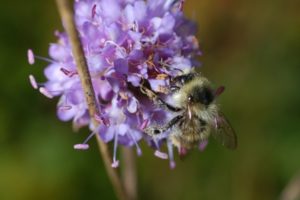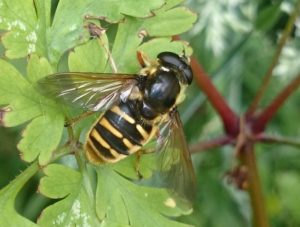Who are our pollinators?
There are over 100 different types of bee and 180 hoverflies on the island of Ireland. Along with other creatures like moths, they provide important pollination services, helping fertilise many of our flowers, crops, and wild plants.
Click on the links below to access full species accounts for each of the species of bee and hoverfly that occur in Ireland
Recording Pollinators
The National Biodiversity Data Centre aims to help drive pollinator conservation through better data. It is entirely reliant on the generosity of volunteer recorders who get involved and submit data on Ireland’s bees and hoverflies. This is particularly important as we move forward with the implementation of the All-Ireland Pollinator Plan.
The Pollinator Plan will only be a success if we see increases in the distribution and abundance of our wild bees and other insects. We are very conscious that without your help in collecting and submitting data we would be unable to track that.
You don’t have to be an expert to contribute. There are a series of ways to get involved:
 1. You can submit casual sightings of bees and hoverflies. These are things you see in your garden, or while you are out and about. All records are very valuable, regardless of how common the species. If you are confident of your identification please submit your sighting on-line or through the smart phone recording app. The Biodiversity Data Capture app is free of charge and is available for iOS and android. If you would like to email a photograph for validation before submitting the record please email Úna
1. You can submit casual sightings of bees and hoverflies. These are things you see in your garden, or while you are out and about. All records are very valuable, regardless of how common the species. If you are confident of your identification please submit your sighting on-line or through the smart phone recording app. The Biodiversity Data Capture app is free of charge and is available for iOS and android. If you would like to email a photograph for validation before submitting the record please email Úna
2. Take part in the Bumblebee Monitoring Scheme. This is our flagship scheme and involves recording bumblebees along a 1-2km fixed route walk of your own choosing once a month from March until October. If you have an hour to spare once a month please consider taking part in this scheme. It provides extremely important data on bumblebee populations, and is used to track changes in wild pollinators across the Irish landscape. More details
3. Carry out a Flower-Insect Timed Count (FIT Count). To carry out a FIT Count you need to watch a patch of flowers for 10 minutes and count how many insects visit. The scheme runs from April to September. You can carry out a FIT Count in any location e.g., garden, farm, park, school. More details
4. Learn to identify some solitary bee species. There are 80 different species of solitary bee in Ireland. Identifying solitary bees to species level generally involves taking a specimen and using a stereo-microscope along with a specialist key. However, there are a small number of species that can be identified in the field by sight. Learn to recognise some of these species and submit your sightings. More details.
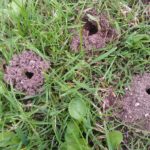
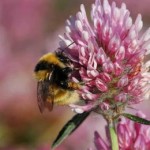 5. Take part in Rare Bumblebee Watch and help us track two of our most endangered bumblebees, the Great yellow bumblebee and the Shrill carder bee. Help by visiting historical locations to check if the species is still there. For each species we have chosen 5 locations to focus on. Visit any of these locations between late June – early September on a good day and let us know if you see the species. More details.
5. Take part in Rare Bumblebee Watch and help us track two of our most endangered bumblebees, the Great yellow bumblebee and the Shrill carder bee. Help by visiting historical locations to check if the species is still there. For each species we have chosen 5 locations to focus on. Visit any of these locations between late June – early September on a good day and let us know if you see the species. More details.
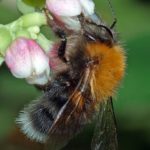 6. Help us track expansion in our two most recent bumblebee arrivals. The Mountain Bumblebee was first recorded in Ireland in the 1970’s from the Dublin/Wicklow Mountains, and then from Northern Ireland in the 1980’s. It is currently expanding its range. The Tree Bumblebee was first spotted in Ireland in September 2017 from St Stephen’s Green in Dublin. Keep an eye out for these species and let us know when you see them so we can track their expansion across the island More details.
6. Help us track expansion in our two most recent bumblebee arrivals. The Mountain Bumblebee was first recorded in Ireland in the 1970’s from the Dublin/Wicklow Mountains, and then from Northern Ireland in the 1980’s. It is currently expanding its range. The Tree Bumblebee was first spotted in Ireland in September 2017 from St Stephen’s Green in Dublin. Keep an eye out for these species and let us know when you see them so we can track their expansion across the island More details.
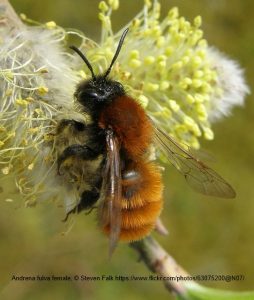 7. Help us look for new populations of very rare species. Currently we are asking volunteers to check their gardens for new populations of the Tawny mining bee. The Tawny Mining bee (Andrena fulva) was though to be extinct for 87 years in Ireland. It was rediscovered in two locations in 2012. It is a very distinctive solitary bee species. Can you help us find any more new populations? More details.
7. Help us look for new populations of very rare species. Currently we are asking volunteers to check their gardens for new populations of the Tawny mining bee. The Tawny Mining bee (Andrena fulva) was though to be extinct for 87 years in Ireland. It was rediscovered in two locations in 2012. It is a very distinctive solitary bee species. Can you help us find any more new populations? More details.
8. Keep an eye out for our latest solitary bee arrivals. The latest two solitary bees to arrive in Ireland are the Ivy Bee (October 2021) and the Hairy-footed Flower Bee (March 2022). It will be very useful to track their expansion across Ireland in the coming years Please keep an eye out and email a photograph if you think you’ve spotted them! More details.
Video: Recording Pollinators
This video will talk about how you can help us understand more about pollinators by recording them.

